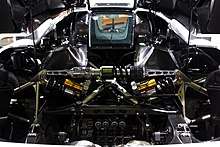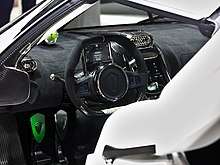Koenigsegg Jesko
The Koenigsegg Jesko is a limited production mid-engine sports car produced by Swedish automobile manufacturer Koenigsegg. Introduced at the 2019 Geneva Motor Show, the car succeeds the Agera. The name Jesko is a tribute to the company founder's father, Jesko von Koenigsegg.[3]
.jpg)
| Koenigsegg Jesko | |
|---|---|
.jpg) Pre-production model at the 2019 Geneva International Motor Show | |
| Overview | |
| Manufacturer | Koenigsegg Automotive AB |
| Production | 2020 (expected) |
| Assembly | Ängelholm, Sweden |
| Designer | Christian von Koenigsegg Joachim Nordwall |
| Body and chassis | |
| Class | Sports car (S) |
| Body style | 2-door targa top |
| Layout | Rear mid-engine, rear-wheel-drive |
| Doors | Dihedral |
| Powertrain | |
| Engine | 5.0 L (5,032 cc; 307.1 cu in) twin-turbocharged V8 |
| Power output | 955 kW (1,298 PS; 1,281 hp) (normal gasoline) 1,195 kW (1,625 PS; 1,603 hp) (E85) |
| Transmission | 9-speed multi-clutch |
| Dimensions | |
| Wheelbase | 2,700 mm (106.3 in)[1] |
| Length | 4,610 mm (181.5 in)[1] |
| Width | 2,030 mm (79.9 in)[1] |
| Height | 1,210 mm (47.6 in)[1] |
| Curb weight | 1,420 kg (3,131 lb)[2] |
| Chronology | |
| Predecessor | Koenigsegg Agera |
The Jesko is primarily built as a high-performance track car, with focus on high aerodynamic downforce and more precise handling. Koenigsegg's other current production model, the Regera, is designed as a grand touring-oriented offering.
Specifications
Engine
.jpg)
The engine is a development of the 5.0-litre twin-turbocharged V8 engine used in the Agera. It has four valves per cylinder each with a bore and stroke of 92 mm × 95.25 mm (3.62 by 3.75 inches) and a compression ratio of 8.6:1. The engine has a power output of 955 kW (1,298 PS; 1,281 hp) on normal gasoline and has a power output of 1,195 kW (1,625 PS; 1,603 hp) and 1,500 N⋅m (1,106 lb⋅ft) of torque at 5,100 rpm on E85 biofuel.[4][5]
Changes from the Agera's engine include the use of a new 180-degree flat-plane crankshaft that saves 5 kg (11 lb) and increases the redline from 8,250 rpm to 8,500 rpm. The Jesko also utilises active rubber mounts from the Regera that reduce engine vibrations in the cabin. The two large turbochargers are equipped with a 20-litre air tank made from carbon fibre, coupled with an electric compressor which feeds pressurised air to the turbochargers at a pressure of 20 bar (290 psi) in order to reduce turbo lag. The engine has pressure sensors for each cylinder in order to achieve real time cylinder monitoring for the multipoint fuel injection system.[3][6]
Transmission
The engine is mated to an in-house developed 9-speed multi-clutch transmission called the "Light Speed Transmission (LST)"[1] by the manufacturer. The new transmission has a weight of 90 kg (198 lb) and it is at least 50% shorter in length than the previous 7-speed dual-clutch unit. It has 21 possible gear combinations (the gears are arranged in two sets of three gears) and seven clutches allowing the driver to jump to any gear without disturbing the ratio. The transmission has a shift time ranging from 20 to 30 milliseconds. It also has an overdrive mode called "Ultimate Power on Demand" that is designed to skip directly to the optimal gear depending on user input, rather than down or upshifting sequentially to that gear.[3][7]
The transmission is controlled by an onboard computer which uses engine and road speed data to engage a gear. Gears are selected by the driver either using the shift paddles mounted on the steering column or the gear selector.[2]
| Gear | Ratio[8] |
|---|---|
| 1st gear | 4.7200:1 |
| 2nd gear | 3.6441:1 |
| 3rd gear | 2.8744:1 |
| 4th gear | 2.2500:1 |
| 5th gear | 1.7371:1 |
| 6th gear | 1.3702:1 |
| 7th gear | 1.0783:1 |
| 8th gear | 0.8325:1 |
| 9th gear | 0.6566:1 |
Chassis and suspension

Unlike its predecessors, the high-downforce variant of the Jesko has Koenigsegg's 'Triplex' dampers at the front and the rear combined with traditional Öhlins dampers. A rear horizontal rear damper prevents the rear from pressing on the ground during hard acceleration. The front dampers stabilise the car at high speeds while an active rear steering ensures further stability at all performance levels.
The carbon tub used in the Jesko is 40 mm (2 in) longer and 22 mm (1 in) wider from that of its predecessor in order for more passenger room. The tub has been redesigned and incorporates an aluminium monocoque structure for increased rigidity.[9]
Wheels, brakes and tyres
.jpg)
The car comes standard with forged aluminium center locking wheels, with diameters of 20 inches at the front and 21 inches at the rear.[1] Lighter carbon fibre wheels are available as an option, weighing 5.9 kg (13 lb) at the front and 7.7 kg (17 lb) at the rear. The tyres are Michelin Pilot Sport Cup 2's with codes of 265/35 20 for the front and 345/30 21 for the rear.[10][3] Michelin Pilot Sport Cup 2 R tyres dedicated for track driving are also available as an option. The braking system uses ventilated carbon-ceramic discs.
Interior

The use of a redesigned monocoque improves leg and headroom in the interior of the Jesko when compared to previous Koenigsegg models. Though weight saving is a priority for interior features, the car is still equipped with amenities such as a climate control system, an infotainment system with a 9.0-inch screen, Apple CarPlay and USB phone charging. The car has unique screens mounted in the steering wheel spokes and a 5.0-inch screen mounted behind the steering wheel displaying vital information to the driver. The seats will be made from hollow carbon fibre but will be electrically adjustable.[2][9]
Exterior
.jpg)
The Jesko shares Koenigsegg's 'Autoskin' capabilities from the Regera, allowing for remote operation of doors and the hood. It is also possible to hydraulically lift the front and rear axles of the car to give additional ground clearance. The doors have been redesigned so that they open further outward and have more ground clearance while open. The roof has screws in order to ensure it remains in place during high speed driving.[9]
Performance

The Jesko is equipped with a large carbon fibre front splitter at the front and a boomerang shaped wing at the rear generating 800 kg (1,764 lb) of downforce at 249 km/h (155 mph), 1,000 kg (2,205 lb) at 275 km/h (171 mph) and 1,400 kg (3,086 lb) at its top speed which is yet to be revealed.[3]
Production
Production of the Jesko will be limited to 125 units, with 40-50 units being produced each year. Unlike its predecessors, the Jesko will be homologated worldwide.[7] It was later announced that the entire build slots of the Jesko were sold out.[11]
The Jesko will be offered in either a high-downforce or low-drag Absolut configuration, with subtle differences between the two variants. The high-downforce variant, as shown at the 2019 Geneva Motor Show, comes equipped with the dual front and rear 'Triplex' damper system and added aerodynamic features for track use.[7] Due to this dual suspension setup, it is not possible to store the Targa roof in the front of the car, although this is possible in the Absolut as it will not have a front 'Triplex' damper system or front hood air dam.[9]
Variants
Jesko Absolut
Unveiled online alongside the Gemera on 3 March 2020, the Jesko Absolut is a high speed version of the Jesko. The rear wing on the track-oriented Jesko is replaced by two rear fins which enable a reduction in downforce from 1,400 kg (3,086 lb) to 150 kg (331 lb) and a drag coefficient of Cd=0.278. The front splitter and side winglets are removed and the front louvers are smoother with the rear wheels featuring removable covers for high speed stability. The vehicle is also slightly elongated featuring a rear extension which adds 85 mm (3 in) of additional length. The engine and transmission remain the same as the standard Jesko. 3,000 hours were spent on the aerodynamic analysis while an additional 5,000 hours were spent design and engineering work of the Absolut. The Absolut will be priced higher than the Jesko due to the development work taken to lower the drag coefficient. The Jesko Absolut is claimed by the manufacturer to have a top speed in excess of 483 km/h (300 mph) in the right conditions.[12][13][14]
References
- "Jesko - Koenigsegg". Koenigsegg. 5 March 2019. Retrieved 5 March 2019.
- Newman, Scott (5 March 2019). "Koenigsegg Jesko revealed: 2019 Geneva Motor Show". Which Car?. Retrieved 5 March 2019.
- Rix, Jack (5 March 2019). "This is the Koenigsegg Jesko, and it's the world's first 300mph car". Top Gear. Retrieved 5 March 2019.
- "Jesko". Koenigsegg. Retrieved 9 December 2019.
- "This is the Koenigsegg Jesko, the world's first 300mph car". Top Gear. 5 March 2019. Retrieved 9 December 2019.
- Bigg, Martin (5 March 2019). "Koenigsegg Jesko Revealed As Agera RS Successor". Carbuzz. Retrieved 5 March 2019.
- Pétrány, Máté (5 March 2019). "The Koenigsegg Jesko Has 1600 HP and Promises a 300-MPH Top Speed". Road & Track. Retrieved 5 March 2019.
- "We Dig Into the Koenigsegg Jesko's revolutionary Light-Speed Transmission". BMW BLOG. 16 March 2019. Retrieved 17 March 2019.
- Vijayenthiran, Viknesh (6 March 2019). "Koenigsegg Jesko deep dive: 7 clutches 1,600 hp, $3M". Motor Authority. Retrieved 7 March 2019.
- Tsui, Chris (5 March 2019). "Koenigsegg Jesko: A Swedish 'Megacar' With 1,600 HP, Seven Clutches, and 300-MPH Top Speed". The Drive. Retrieved 5 March 2019.
- "Koenigsegg Jesko Sold Out". Koenigsegg. 19 March 2019. Retrieved 19 March 2019.
- Szymkowski, Sean (3 March 2020). "Koenigsegg Jesko Absolut: This supercar has a date with 300 mph". Roadshow by CNET. Retrieved 3 March 2020.
- Perkins, Chris (5 March 2020). "The Koenigsegg Jesko Absolut Can Do 330 MPH in Theory, But it Needs Space". Road & Track. Retrieved 6 March 2020.
- Padeanu, Adrian (3 March 2020). "Koenigsegg Jesko Absolut Revealed As The Fastest Car Koenigsegg Would Ever Make". Motor1. Retrieved 6 March 2020.